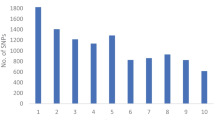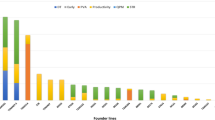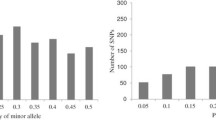Abstract
Understanding the genetic relationships among broad-based populations is a good starting point for breeding programs. These utilize introduction and adaptation of tropical and temperate populations to broaden the genetic resources for genetic improvement. A diallel of 16 maize populations adapted to the northern U.S. Corn Belt was used to estimate population genetic parameters. These were used to assess genetic diversity and assign the populations to heterotic groups. Using the general combining ability (g i ) estimates, 19 agronomic and grain quality traits showed large contribution on the variability of the first two principal components. All traits were used to characterize the genetic similarities among the populations. The cluster analysis formed three groups and a singleton based on genetic distances (GD) of g i estimates. The specific heterosis (s ij ) estimates for grain yield were used to assign the 16 populations to heterotic groups, since there was a positive correlation between GD and s ij . Four heterotic groups were established. These showed a good agreement with that formed using GD. The heterotic grouping agreed with genetic background information and heterotic group’s specific and general combining ability estimates. The EARLYGEM 21 populations with exotic background were assigned to a unique heterotic group. They showed high heterosis when crossed with a tropical population and populations belonging from other heterotic groups. The heterotic groupings among the 16 populations validated former heterotic groups, and new heterotic patterns were created. These results will increase breeding efficiency in developing new cultivars for the northern U.S. Corn Belt.



Similar content being viewed by others
References
Badu-Apraku B, Menkir A, Fakorede MAB, Lum AF, Obeng-Antwi K (2006) Multivariate analyses of the genetic diversity of forty-seven Striga resistant tropical early maturing maize inbred lines. Maydica 51:551–559
Badu-Apraku B, Oyekunle M, Akinwale RO, Aderounmu M (2013a) Combining ability and genetic diversity of extra-early white maize inbreds under stress and nonstress environments. Crop Sci 53:9–26
Badu-Apraku B, Oyekunle M, Fakorede MAB, Vroh I, Akinwale RO, Aderounmu M (2013b) Combining ability, heterotic patterns and genetic diversity of extra-early yellow inbreds under contrasting environments. Euphytica. doi:10.1007/s10681-013-0876-4
Barata C, Carena MJ (2006) Classification of North Dakota maize inbred lines into heterotic groups based on molecular and testcross data. Euphytica 151:339–349
Betran FJ, Ribaut JM, Beck D, de Leon DG (2003) Genetic diversity, specific combining ability, and heterosis in tropical maize under stress and nonstress environments. Crop Sci 43:797–806
Camussi A, Ottaviano E, Calinski T, Kaczmarek Z (1985) Genetic distances based on quantitative traits. Genetics 111:945–962
Carena MJ (2013) Developing the next generation of diverse and healthier maize cultivars tolerant to climate changes. Euphytica 190:471–479
Carena MJ, Hallauer AR (2001a) Expression of heterosis in Leaming and Midland Corn Belt Dent populations. J Iowa Acad Sci 108:73–78
Carena MJ, Hallauer AR (2001b) Response to inbred progeny selection in Leaming and Midland Yellow Dent maize populations. Maydica 46:1–10
Carena MJ, Wanner DD (2005) Registration of NDSAB(MER-FS)C13 maize germplasm. Crop Sci 45:1670
Carena MJ, Eno C, Wanner DD (2008) Registration of NDBS11(FR-M)C3, NDBS1011, and NDBSK(HI-M)C3 maize germplasm. J Plant Regist 2:132–136
Carena MJ, Pollak L, Salhuana W, Denuc M (2009) Development of unique and novel lines for early-maturing hybrids: moving GEM germplasm northward and westward. Euphytica 170:87–97
Cross HZ (1982) Registration of maize germplasm (Reg. no. GP117 and GP118). Crop Sci 20:1270
Cross HZ (1983) Registration of NDSAB and NDSF maize germplasm. Crop Sci 23:1227
Cross HZ (1988) Registration of NDSCD, NDSK(FS)C1, and NDSF maize germplasm. Crop Sci 28:201–202
Cross HZ, Wanner DD (1991) Registration of NDSAB(MS)C8(LM)C3, NDSD(FS)C1(LM)C4, and NDSM maize germplasm. Crop Sci 31:239
Dado RG (1999) Nutritional benefits of speciality corn grain hybrids in dairy diets. J Anim Sci 77:197–207
Eagles HA, Lothrop JE (1994) Highland maize from central Mexico. Its origin, characteristics, and use in breeding programs. Crop Sci 34:11–19
Eno C, Carena MJ (2008) Adaptation of elite temperate and tropical maize populations to North Dakota. Maydica 53:217–226
Fan XM, Zhang YM, Hao WH, Chen HM, Tan J, Xu CX, Han XL, Luo LM, Kang MS (2009) Classifying maize inbred lines into heterotic groups using a factorial mating design. Agron J 101:106–112
Froyer AF, Openshaw SJ, Knittle KH (1988) Measurement of genetic diversity among popular commercial corn hybrids. Crop Sci 28:481–485
Gardner CO, Eberhart SA (1966) Analysis and interpretation of the variety cross diallel and related populations. Biometrics 22:439–452
Hallauer AR (1967) Development of single-cross hybrids from two-eared maize populations. Crop Sci 7:192–195
Hallauer AR, Russell WA, White PR (2000) Registration of BS21(R)C7 and BS22(R)C7 maize germplasm. Crop Sci 40:1517
Hanson WD, Casas E (1968) Spatial relationship among eight populations of Zea mays L. utilizing information from a diallel mating design. Biometrics 24:867–880
Laude TP, Carena MJ (2014) Diallel analysis among 16 maize populations adapted to the northern U.S. Corn Belt for grain yield and grain quality traits. Euphytica 200:29–44
Lee EA, Chakravarty R, Good B, Ash MJ, Kannenberg LW (2006) Registration of 38 maize (Zea mays L.) breeding populations adapted to short-season environments. Crop Sci 46:2728–2733
Littell RC, Milliken GA, Stroup WW, Wolfinger RD, Schabenberger O (2006) SAS for mixed models, 2nd edn. SAS Institute Inc., Cary
Mantel N (1967) The detection of disease clustering and a generalized regression approach. Cancer Res 27:209–220
Melani MD, Carena MJ (2005) Alternative maize heterotic patterns for the northern Corn Belt. Crop Sci 45:2186–2194
Melchinger AE, Gumber RK (1998) Overview of heterosis and heterotic groups in agronomic crops. In: Lamkey KR, Staub JE (eds) Concepts and breeding of heterosis in crop plants. CSSA Spec Publ 25. CSSA, Madison, pp 29–44
Melchinger AE, Messmer MM, Lee M, Woodman WL, Lamkey KR (1991) Diversity and relationships among U.S. maize inbreds revealed by restriction fragment length polymorphism. Crop Sci 31:669–678
Milligan GW, Cooper MC (1988) A study of standardization of variables in cluster analysis. J Classif 5:181–204
Mohammadi SA, Prasanna BM (2003) Analysis of genetic diversity in crop plants—salient statistical tools and considerations. Crop Sci 43:1235–1248
Moll RH, Salhuana WS, Robinson HF (1962) Heterosis and genetic diversity in variety crosses of maize. Crop Sci 2:197–198
Moll RH, Lonnquist JH, Fortuno JV, Johnson EC (1965) The relationship of heterosis and genetic divergence in maize. Genetics 52:139–144
Osorno JM, Carena MJ (2008) Creating groups of maize genetic diversity for grain quality: implications for breeding. Maydica 53:131–141
Padilla G, Cartea ME, Ordas A (2007) Comparison of several clustering methods in grouping kale landraces. J Am Soc Hortic Sci 132:387–395
Prasad SK, Singh TP (1986) Heterosis in relation to genetic divergence in maize (Zea mays L.). Euphytica 35:919–924
Reif JC, Hallauer AR, Melchinger AE (2005) Heterosis and heterotic patterns in maize. Maydica 50:215–223
Rohlf FJ (2000) NTSYSpc. Numerical taxonomy and multivariate analysis system. Version 2.1. Applied Biostatistics Inc., Port Jefferson
SAS Institute Inc (2010) SAS/STAT user’s guide, 3rd edn. SAS Institute Inc., Cary
Scott MP, Edwards JW, Bell CP, Schussler JR, Smith JS (2006) Grain composition and amino acid content in maize cultivars representing 80 years of commercial maize varieties. Maydica 51:417–423
Sezegen B, Carena MJ (2009) Divergent recurrent selection for cold tolerance in two improved maize populations. Euphytica 167:237–244
Sneath PHA, Sokal RR (1973) Numerical taxonomy. Freeman, San Francisco
Sokal RR (1986) Phenetic taxonomy: theory and methods. Annu Rev Ecol Syst 17:423–442
Tabachnick BG, Fidell LS (2001) Computer-assisted research design and analysis. Allyn & Bacon, Boston
Zhang Y, Kang MS, Lamkey KR (2005) DIALLEL-SAS05: a comprehensive program for Griffing’s and Gardner-Eberhart analyses. Agron J 97:1097–1106
Author information
Authors and Affiliations
Corresponding author
Rights and permissions
About this article
Cite this article
Laude, T.P., Carena, M.J. Genetic diversity and heterotic grouping of tropical and temperate maize populations adapted to the northern U.S. Corn Belt. Euphytica 204, 661–677 (2015). https://doi.org/10.1007/s10681-015-1365-8
Received:
Accepted:
Published:
Issue Date:
DOI: https://doi.org/10.1007/s10681-015-1365-8




